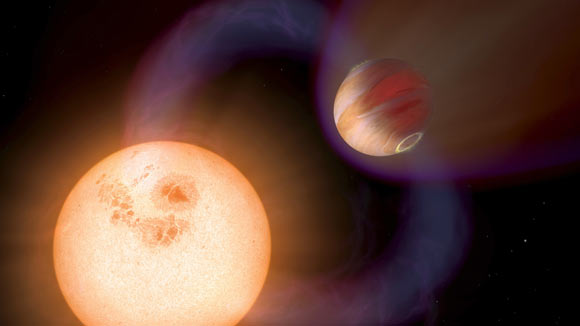Hot Jupiters Have Powerful Magnetic Fields | Astronomy – Sci-News.com
Hot Jupiters — massive gaseous exoplanets orbiting close to their host stars — have surprisingly powerful magnetic fields, many times stronger than our Solar System’s Jupiter, according to a paper published in the journal Nature Astronomy.

This illustration shows a hot Jupiter orbiting so close to a red dwarf star that the magnetic fields of both interact, producing activity on the star. Image credit: NASA / ESA / A. Schaller, STScI.
Hot Jupiters are gas giants presumed to be like Jupiter but orbiting their host stars at close distances, typically about five times the star’s diameter, or roughly 20 times the Moon’s distance from Earth.
The close orbits of hot Jupiters make it possible for these objects to experience strong interactions with their stars via tides, collisions with stellar wind particles, accretion of planetary gas onto the star’s surface and magnetic reconnection between the stellar and planetary magnetic field lines.
Star-planet interactions can potentially reveal details about stellar wind properties and, most intriguingly, planetary magnetic fields.
“Our study is the first to use observed signals of star-planet interactions to derive exoplanet magnetic field strengths,” said Dr. Evgenya Shkolnik, an astronomer at Arizona State University.
“These signals appear to come from interactions between the magnetic fields of the star and the tightly orbiting planet.”
Dr. Shkolnik’s team used ground-based telescopes in Hawaii and France to acquire high-resolution observations of emission from ionized calcium (Ca II) in the parent stars of the four hot Jupiters: HD 179949, HD 189733, τ Boötis and υ Andromedae.
The emission comes from a star’s hot, magnetically heated chromosphere, a thin layer of gas above the cooler stellar surface.
The observations let the team calculate how much energy was being released in the stars’ calcium emission.
“We used the power estimates to calculate magnetic field strengths for the planets using a theory for how the planets’ magnetic fields interact with the stellar magnetic fields,” Dr. Shkolnik said.
The magnetic field strengths the researchers found range from 20 to 120 G (gauss) — around 10-100 times larger than predicted values.
For comparison, Jupiter’s magnetic field is 4.3 G and Earth’s field strength is only 0.5 G, although that is strong enough to orient compasses worldwide.
“The field strengths are larger than one would expect considering only the rotation and age of the planet,” the study authors said.
“The standard dynamo theory of planetary magnetic fields predicts field strengths for the sampled planets that are much smaller than what we found.”
“Instead, the observations support the idea that planetary magnetic fields depend on the amount of heat moving through the planet’s interior. Because they are absorbing a lot of extra energy from their host stars, hot Jupiters should have larger magnetic fields than planets of similar mass and rotation rate.”
“We are pleased to see how well the magnitude of the field values corresponded to those predicted by the internal heat flux theory. This may also help us work toward a clearer understanding of magnetic fields around temperate rocky planets,” Dr. Shkolnik said.
_____
P. Wilson Cauley et al. Magnetic field strengths of hot Jupiters from signals of star-planet interactions. Nature Astronomy, published online July 22, 2019; doi: 10.1038/s41550-019-0840-x





